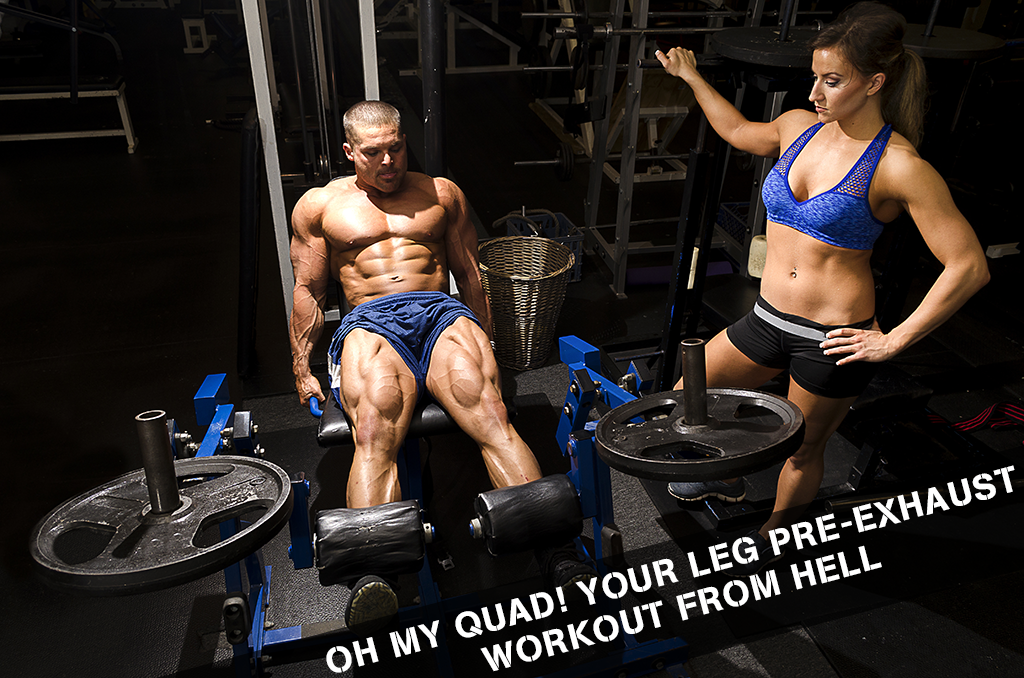
Leg training is brutal – if you’re doing it right. No successful bodybuilder ever picks up his trophy on the national level stage, crushing the competition, without first crushing hundreds of very long and painful leg days. No champion at any level reaches this point without spending countless hours, days, weeks, and months plugging away in the gym, facing down the most painful of exercises targeting the lower body. Building big wheels requires great commitment, and quad development is what truly separates those lifters with “solid” work ethic from those with superhuman work ethic! And one tool used by the superhuman athletes of the group is known as pre-exhaust training.
Many questions exist which keep people from using pre-exhaust training for the legs, or from using is correctly. Let’s answer them, and look at a few ways you can make your leg workouts and more effective through the use of pre-exhaust quadriceps training!
First off, what is pre-exhaust training?
This sort of training is simple to describe. Start by completing one set of an isolation movement. Then, immediately move to a compound movement for the same muscle group, and complete a set of that. Two sets, performed right after each other. It’s really that simple! The idea being this training methodology is that the lifter exhausts the targeted larger muscle group with the first set. Then, for the second set, the target muscle group has to do MORE WORK, because it is already tired, which forces it to grow.

Can I use pre-exhaust training with any muscle group?
You can use pre-exhaust training with any muscle group. However, the larger muscle groups of the body, such as the chest, back, and legs, will benefit greater from pre-exhaust training. Their higher number of muscle fibers, coupled with the amount of weight moved, equates to a greater impact, the larger the muscle group being trained. Smaller muscle groups such as the calves or biceps will always enjoy several sets in a row, but if the entire muscle group is being used, with few other muscle groups contributing to the mix, then pre-exhaust isn’t really taking place – it’s just super setting at that point.
What exercises should I be using?
First off, you will want to choose the right movements. And, you’ll want to know if they are considered to be isolation movements, or compound leg movements. Exercises such as leg extensions, leg curls, adductor/abductor machines, and any cable work for legs are considered to be isolation movements. They should be placed FIRST in your leg superset as the start of the pre-exhaust movement. Then, you will want to choose an exercise such as squats, leg press, lunges, or still-legged deadlifts, to complete the set. Your quads will be burning from the isolation work, such as leg extensions. Then you’ll finish them with a big heavy compound movement, forcing to quads to work very hard after starting the set already exhausted. Pushing the quads to new levels is one way to facilitate new muscle growth.
What kind of timing should you use with pre-exhaust training?
You’ll want to move from the 1st to 2nd exercises with zero break in between. The only break between your compound sets should be just as long as is required for your breathing rate to return to near-normal levels.
How much of your workout should be composed of pre-exhaust training? There are some factors to consider when making this call, particularly when it comes to recovery. Pre-exhaust for the quads leaves most lifters limping and staggering for days at a time.

Are there any dangers to using pre-exhaust training for the legs?
The more you torch your muscle fibers, the sooner you will lose the strong foundation and balance which you regularly enjoy. Plan for this! Don’t schedule free weight barbell squats or lunges with pre-exhaust movements if you can’t take care of yourself in the days following the training. Big meals, lots of water, and plenty of rest are desired if you want to bounce back from such tough training bigger and stronger the following week.
Should I try pre-exhaust training in crowded gyms?
This is a tricky one which can often lead to confrontation or disagreement. Common courtesy explains that you should only dominate ONE machine at a time in the gym, and let others work in too. If you are flexible and courteous to those around you, and don’t feel a sense of entitlement to any machine or station, others around you should be flexible as you work through your pre-exhaust and super sets.
With most things in life, people are always looking for ways to make things easier. With leg training, the opposite is very much true. The athlete who trains legs harder will have a better set of wheels on the competition stage. The athlete who spends more hours in the gym, saturating the legs with compound lifts after isolation movements – also known as pre-exhaust – will torch his or her legs beyond comprehension.


